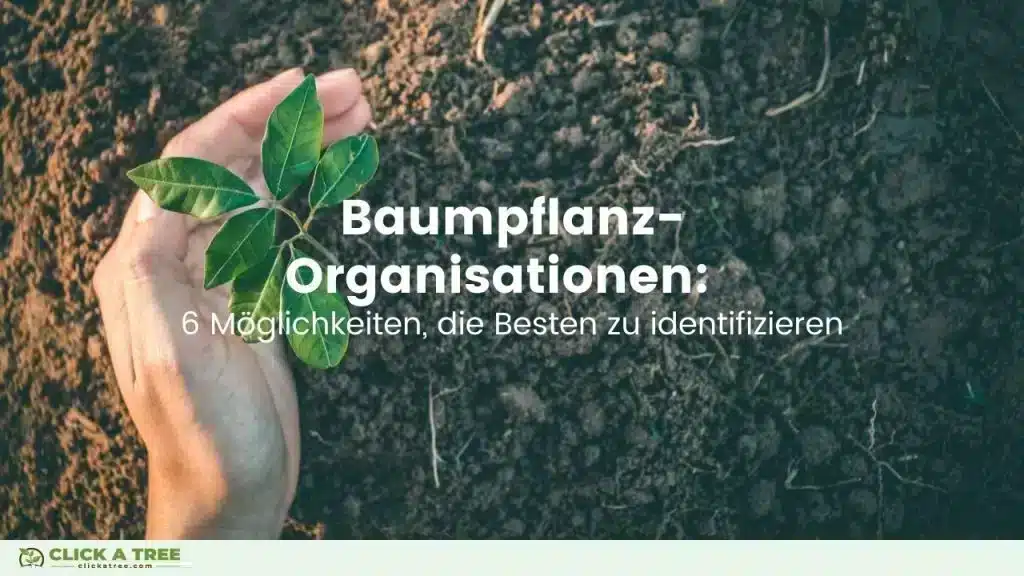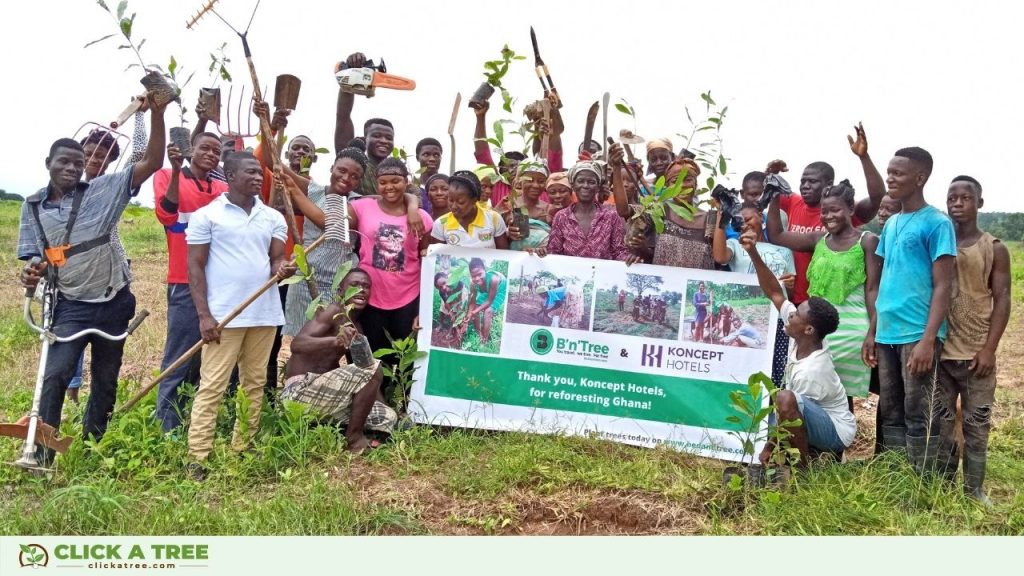Tree planting organizations
6 ways to identify the best
There are thousands of tree planting organizations around the world, and we are often asked which one is the best. Our counter questions are: What is important to you in a reforestation company? What is your motivation and do you have a strategy? And who benefits from planting these trees?
To help you decide, we’ve put together this complete guide to planting trees. It will help you find the best tree planting organizations that plant trees exactly the way you want them to. And then you can quickly help to reforest the planet!
The best tree planting organizations
How do you decide which tree planting organizations are the best? Should they get into a ring and fight to see who is the best?
Of course not. Nevertheless, it is difficult to answer this question. Just like: What is the best car? What is the most beautiful color?
Determining the best tree planting organizations depends on your values, your expectations, your preferences and your desired impact. The organization that plants trees must be the best for YOU.
We’ve put together 6 questions you should ask yourself before choosing your favorite tree planting organizations and contributing to the reforestation of our planet.
Remember that there is no right or wrong answer to any of these questions. In 99.99% of cases, it is better to plant a tree than not to plant a tree at all.
Why: Your tree planting motivation
Let’s start with the most important question: Why do you want to plant trees in the first place?
Is it to combat climate change? Or to create habitats for endangered species? To offset the CO2 emissions of your travels? To restore water cycles, stop erosion and prevent desertification?
Or are you looking for tree planting organizations that plant trees to generate a full-time income for people in less privileged regions instead?
Regardless of your personal motivation, the “why” is one of the most important factors, as most approaches differ in the “why”.
At Click A Tree, our original motivation was to create a habitat for elephants. We have therefore decided to plant a variety of different tree species and create diversified ecosystems.
Of course, these trees are also combating climate change. And because our forests are so diverse, they are also ideally prepared to withstand the challenges of a changing climate.
Building on this strategy, we have decided to avoid working with volunteers and instead employ full-time staff to plant and maintain the trees.
In this way, planting trees also creates stable incomes for many families and communities and makes tree planting holistically sustainable.
We have now managed to support 16 of the 17 Sustainable Development Goals set by the United Nations.
And you can do that by simply planting a tree. (Or three. The more, the better.)
So we have dealt with the “why” – now it’s about the “who”.
Who: Types of workers and types of tree planting organizations
Who should plant your trees?
Should it be volunteers doing this to gain life experience, e.g. students doing a year abroad? Should it be schoolchildren who want to learn about the importance of environmental protection?
Or would you rather see full-time employees earn a decent wage by planting and caring for your trees?
And there is something else to consider: Should these full-time employees be “Western” professionals? Or should they be people in less affluent regions of our planet?
Tree planting organizations from all over the world choose different paths here.
And as already mentioned, there is no right or wrong here. Every approach is valuable and we are not here to judge your answer as “pass” or “fail”.
However, if you consider the “who”, you can quickly identify the organizations that are planting trees using your preferred approach – and those that are not.
Click A Tree: Why we only plant trees with full-time employees
At Click A Tree we have tried all three approaches: western volunteers; school children; and full-time employees.
In the end, we decided to work exclusively with full-time employees. The two main reasons are that, on the one hand, we firmly believe that the people who work hard to protect our planet should earn a fair and full-time income for their efforts.
On the other hand, employing full-time staff produces better results in the long term. The trees have been tended and cared for by increasingly experienced employees for many years.
This knowledge and experience have a great influence on the survival rates of the trees.
There is a big difference between throwing a seed into the ground and “pre-growing” and nurturing a seedling until it can survive on its own.
This is not the only approach, but it fits best with our vision and values.
Charitable tree planting organizations compared with non-charitable organizations
Another part of the “Who” looks more closely at the type of organizations that plant trees. Is the reforestation organization a charity? Or a company?
Click A Tree is not a charity organization. We are a profit-oriented company. This is because we firmly believe that the people who contribute to protecting our planet should also make a profit.
Click A Tree’s way
Here’s why: making a profit motivates even more people to get involved in activities to save the planet. And that’s exactly what we need: a lot of highly motivated people who are all interested in making our planet a better place.
And as long as we live in a capitalist environment, people have to earn a living and profit from their efforts. Otherwise, the attraction of a job with a higher salary becomes too tempting.
These winnings don’t even have to be super high. But fair compensation for the people who work hard to make our planet a better place is fair business, right?
Imagine how quickly our planet would change if we combined community service with a capitalist system. That is caritalism.
Where: Plant trees in your garden? In your region? Global?
Where should the trees be planted?
How about in your own garden so you can sit in their shade? Or in your community forest, so you can visit and hug it from time to time?
In the country where you live? Or a country with a lower GDP where the tree creates a source of income for the local population?
Should your favorite tree planting team grow your tree in the tropics, home to most of our biodiversity and the climate zone where trees grow faster without winter breaks? Rapid growth ensures rapid carbon sequestration – good news for our global climate.
Or do you not care where?
At Click A Tree, most of our trees are planted in tropical regions. Firstly, because trees grow faster there.
And since there is no winter break, the trees can store more CO2 in a shorter period of time.
Secondly, because planting trees in the tropics is generally cheaper than in the USA or Germany, for example, where the cost of a tree is much higher (due to higher land prices and labor costs).
And finally, because we believe that the work and stable income are urgently needed in the countries where we plant trees.
And, as mentioned above, this helps to make the entire company holistically sustainable.
What: Which strategy is important to you? Do you prefer tree planting organizations that plant specific trees?
Ask yourself which tree species you want to plant in order to choose the reforestation organization you want to plant trees with.
Do you want to plant the cheapest trees so that you can plant as many trees as possible? (Warning: this can lead to monocultures, which often do more harm than good to the environment!)
Or can you pay a little more to ensure that the best (aka most useful) tree is planted, carefully selected to grow in the local conditions?
Would you also like to plant fruit trees so that the farmers can harvest the fruit to eat and sell?
Or would you rather create a diverse ecosystem as a habitat for endangered animals, store as much CO2 as possible, restore the water cycle, stop desertification and prevent soil erosion?
Or do you prefer a simple combination of the latter two strategies?
Funnily enough, this is also an option. It is called Syntropic Agriculture and we are implementing it in Ghana.
With Click A Tree, we use different approaches in different projects. On the coasts we mainly plant mangroves, as there are not many trees that survive in brackish water (a mixture of salt and fresh water).
In Thailand, we focus mainly on creating habitats for animals and promoting biodiversity.
And in Ghana, we are developing a food plantation for the local community and creating a diverse forest at the same time. (And as if that wasn’t enough, we also support a local entrepreneurship school where unemployed young people learn how to create a better future for themselves).
Yes, you’re right. Here you are spoiled for choice. (If you were to ask us: Plant one of each. Our planet needs it).
We don’t let you choose the type of tree you plant. If we did that, most people would plant the cheapest tree species available, and that would lead to a monoculture.
Instead, we plan exactly which tree species are needed and in what quantity, and then create a mixed calculation to ensure that dozens of different species are planted.
It makes your life easier (one less choice) and creates an extremely diverse ecosystem.
And this is important because it is the best way to prepare forests for the increasing challenges of climate change.
Which one: Which tree planting strategy is the smartest?
Let’s take a closer look at this. Which tree species should be planted? In which combination? With what strategy?
These are complex questions, and we bet you probably don’t want to spend all day thinking about tree planting strategies. That’s the job of the reforestation organization, isn’t it?
But remember: it’s worth thinking briefly about the strategy of the tree planting organization you want to support.
Tree planting strategies
Should they throw the seedling in the ground and walk away? Or throw the so-called seed bombs?
Or pre-grow the seeds in a nursery and then plant the seedling?
Does the tree planting organization continue to nurture the seedling once it is planted in the field to maximize survival rates?
The more time invested in a tree, the greater its chance of survival.
Tree species
You also need to consider the tree species.
Does the reforestation company plant a single tree species, which would lead to a monoculture? Or does it plant a variety of tree species? And do the selected species benefit each other?
It takes longer and is more expensive to pre-grow different tree species and follow a plan that promotes symbiosis. But isn’t that a wise investment?
Our mission at Click A Tree is to create different ecosystems as habitats for animals.
We plan which tree species are to be planted, we pre-breed them in a tree nursery, plant them out in the field after 3-6 months and then continue to care for them for up to twelve years.
In this way, all these small trees grow into a healthy, self-sustaining forest.
Even if it’s a forest, we check it regularly to make sure things are going as planned and prune the trees here and there if necessary.
And yes, we pay all local people for the entire period of their involvement, creating many stable, long-term incomes, which improves the local economy. Everyone wins.
When: When is the best time to plant trees?
This is a trick question – when is the best time to plant a tree?
But seriously, if you decide to plant a tree in your garden, you should check when is the best time to plant that particular tree species in your region. Or call a local expert to take care of it instead.
If you are planting with Click A Tree, now is the best time to do so.
Of course, your tree will not go into the ground the moment you click on “Order”. Instead, we collect the orders and plant the trees at the right time, depending on the region you choose.
We take orders all year round, then prepare our nursery, source the seeds and start at just the right time to pre-plant your seeds in the nursery so they are ready for the field when it rains.
But trust us, don’t wait for the right moment. Plant a tree now!
Identifying the best tree planting organization
Now you know what questions to ask yourself if you want to find the best organization for planting trees.
Unfortunately, not all reforestation companies are 100% transparent about their methods. In this case, here are some tips to help you find the best tree planting organizations for you.
Who is behind the tree planting organizations?
First of all, who runs the organization that plants your trees? Can you find them on Facebook or LinkedIn? Do they show their face or hide behind a company logo?
Do they react? Send them an e-mail or give them a call. If you don’t hear from them, don’t plant trees with them.
Check the images of tree planting campaigns
Check the images on their websites and social channels. Do they show children with plants? You could plant with schools.
Are there 18-year-old Westerners who proudly pose with a sapling among Kenyans? These would most likely be volunteers.
As I said – neither of these is a bad thing. It just depends on whether you prefer to support volunteers or professional tree planters.
Are your pictures current and unique? (By “current” we mean photos that are 6 to 12 months old. It’s not always planting season and it wouldn’t make sense to upload a new photo of the same tree every week).
In addition, tree planting teams quite often focus on one thing: planting trees!
However, if the most recently uploaded photos are 10 years old, this could be a sign that the company is no longer as active these days.
Check the website and social channels of the tree planting organizations
First step in finding an organization that plants trees: check out their website. Do they inform you about their reforestation projects and methods?
If not, that’s a red flag. If you have time, give them a call or send an email to see what they say.
Alternatively, you can plant trees with a reforestation company that is transparent about its methods.
Can you find many volunteer events on a tree planting organization’s website and social channels? This shows that they are planting with volunteers.
Take part in planting trees
Sign up for one – it’s fun! And it also shows you how much hard work goes into planting a tree.
You will probably plant the sapling that day – it has been pre-grown and will (hopefully) be tended by someone else afterwards.
In the end, you have to decide for yourself whether you prefer to leave large-scale reforestation projects in the hands of volunteers or full-time professionals.
Tree planting organizations and transparency
Do you know what your money is being used for?
Are the tree planting organizations demanding “20 USD for reforestation projects”? Or do you get “1 tree for $20USD?”
There is no right or wrong here either. However, the last approach is somewhat more “tangible” than the first.
Whether this is important to you or not is entirely up to you.
The cost of a tree
We have already explained in detail how much it costs to plant a tree.
But consider the cost of land, authorizations and bureaucracy. You plan, buy the right tools, procure the seeds and transport them to the nursery.
Then you need time and effort to pre-grow the seedlings, prepare the field, install the irrigation, plant the tree seedlings in the field and then nurture them for years to come.
How much would you charge for all this?
Fair prices for trees
Be fair and pay a fair price for other people who do all this for you. How would you feel if you did something good for Mother Nature by planting a tree, but exploited a person in less favorable conditions? Would you plant a tree for a penny?
When we become sustainable, it should be holistically sustainable. This way, everyone benefits: you, the local community and the local and global ecosystem.
Doesn’t that sound wonderful?
Is Click A Tree the best tree planting organization?
And now we return to your original question! Is Click A Tree one of the best tree planting organizations or even the best ever?
The answer is:
You decide.
Of course, we have created and developed Click A Tree in such a way that it is fair for everyone involved and is considered holistically sustainable.
We are definitely proud of what we do and think we are doing things right.
But we are also aware that other people have different values. So you might be more interested in another company.
Regardless of your priorities, we firmly believe that planting a tree is almost always better than not planting a tree.
If we are the team you trust, we are honored! And we will continue to do our best to plant and nurture your tree until it becomes a tall, beautiful and precious symbol of your devotion.
And if we’re honest, planting trees doesn’t cost the earth, does it? (Unfortunately, not planting trees could cost us the world. But that’s the subject of another story).
Remember, it’s better to plant trees than not, so don’t overthink things. Plant a tree today!
Oh, and: Should you decide not to plant a tree: Let us know why.
Let us know what you think good tree planting organizations should consider.
We are always happy to receive constructive feedback, as we are always striving to improve.
Get the latest updates on new tree planting locations: Follow us on Facebook and Instagram.
Thank you for your support!

























